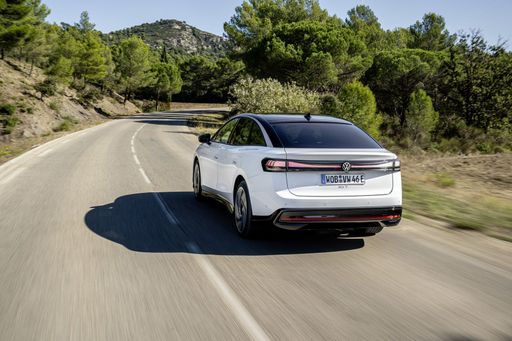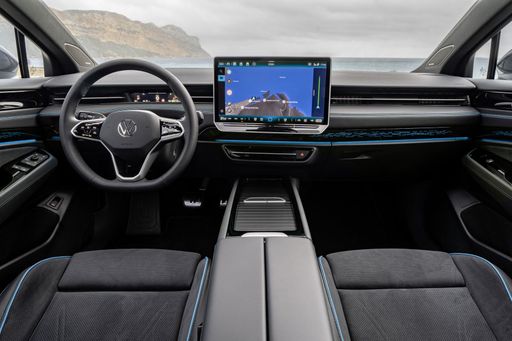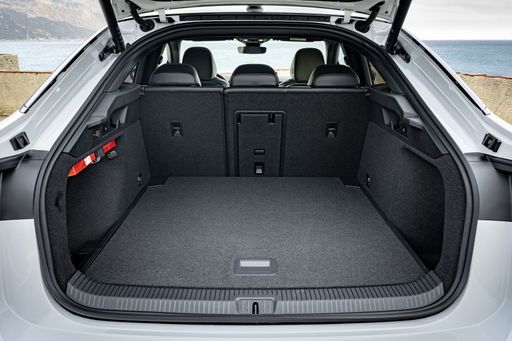Alfa Romeo Junior vs VW ID.7 – Which model is better for everyday use?
Compare performance, boot capacity, efficiency and price at a glance.
Find out which car is the better choice for you – Alfa Romeo Junior or VW ID.7?
Costs and Efficiency:
Looking at overall running costs, both models reveal some interesting differences in everyday economy.
Alfa Romeo Junior has a decisively advantage in terms of price – it starts at 25700 £, while the VW ID.7 costs 46400 £. That’s a price difference of around 20704 £.
In terms of energy consumption, the advantage goes to the VW ID.7: with 13.60 kWh per 100 km, it’s a bit more efficient than the Alfa Romeo Junior with 15.10 kWh. That’s a difference of about 1.50 kWh.
As for range, the VW ID.7 performs convincingly better – achieving up to 708 km, about 298 km more than the Alfa Romeo Junior.
Engine and Performance:
Under the bonnet, it becomes clear which model is tuned for sportiness and which one takes the lead when you hit the accelerator.
When it comes to engine power, the VW ID.7 has a somewhat edge – offering 340 HP compared to 280 HP. That’s roughly 60 HP more horsepower.
In acceleration from 0 to 100 km/h, the VW ID.7 is hardly perceptible quicker – completing the sprint in 5.40 s, while the Alfa Romeo Junior takes 5.90 s. That’s about 0.50 s faster.
In terms of top speed, the Alfa Romeo Junior performs somewhat better – reaching 206 km/h, while the VW ID.7 tops out at 180 km/h. The difference is around 26 km/h.
There’s also a difference in torque: VW ID.7 pulls clearly stronger with 679 Nm compared to 345 Nm. That’s about 334 Nm difference.
Space and Everyday Use:
Cabin size, boot volume and payload all play a role in everyday practicality. Here, comfort and flexibility make the difference.
Both vehicles offer seating for 5 people.
In curb weight, Alfa Romeo Junior is convincingly lighter – 1380 kg compared to 2180 kg. The difference is around 800 kg.
In terms of boot space, the VW ID.7 offers clearly perceptible more room – 532 L compared to 415 L. That’s a difference of about 117 L.
In maximum load capacity, the VW ID.7 performs somewhat better – up to 1586 L, which is about 306 L more than the Alfa Romeo Junior.
When it comes to payload, VW ID.7 barely noticeable takes the win – 465 kg compared to 420 kg. That’s a difference of about 45 kg.
Who comes out on top?
Overall, the VW ID.7 shows itself to be outperforms in nearly all aspects and secures the title of DriveDuel Champion.
It convinces with the more balanced overall package and proves to be the more versatile choice for everyday use.
 @ Volkswagen AG / VW Media
@ Volkswagen AG / VW Media
VW ID.7
Alfa Romeo Junior
The Alfa Romeo Junior captures the essence of Italian design with its sleek lines and compact dimensions, making it an icon of elegance and performance. With a spirited driving experience and a charming retro aesthetic, it appeals to enthusiasts and casual drivers alike. This delightful car embodies the brand's rich heritage while remaining a fun and engaging option for those seeking a unique automotive experience.
details @ Alfa Romeo / Stellantis Media
@ Alfa Romeo / Stellantis Media
 @ Alfa Romeo / Stellantis Media
@ Alfa Romeo / Stellantis Media
 @ Alfa Romeo / Stellantis Media
@ Alfa Romeo / Stellantis Media
VW ID.7
The VW ID.7 represents a significant step forward in Volkswagen's electric vehicle lineup, offering an elegant design combined with advanced technology features. This electric saloon showcases a sleek aerodynamic profile, prioritising both performance and efficiency. Inside, drivers will appreciate the spacious and modern cabin, equipped with intuitive controls and connectivity features for a seamless driving experience.
details @ Volkswagen AG / VW Media
@ Volkswagen AG / VW Media
 @ Volkswagen AG / VW Media
@ Volkswagen AG / VW Media
 @ Volkswagen AG / VW Media
@ Volkswagen AG / VW Media
 @ Volkswagen AG / VW Media
@ Volkswagen AG / VW Media
 @ Alfa Romeo / Stellantis Media
@ Alfa Romeo / Stellantis Media
|
 @ Volkswagen AG / VW Media
@ Volkswagen AG / VW Media
|
|
|
|
Costs and Consumption |
|
|---|---|
|
Price
25700 - 41600 £
|
Price
46400 - 54200 £
|
|
Consumption L/100km
4.8 - 5.4 L
|
Consumption L/100km
-
|
|
Consumption kWh/100km
15.1 - 17.5 kWh
|
Consumption kWh/100km
13.6 - 16.2 kWh
|
|
Electric Range
344 - 410 km
|
Electric Range
594 - 708 km
|
|
Battery Capacity
0.4 - 51 kWh
|
Battery Capacity
77 - 86 kWh
|
|
co2
0 - 119 g/km
|
co2
0 g/km
|
|
Fuel tank capacity
44 - 45 L
|
Fuel tank capacity
-
|
Dimensions and Body |
|
|---|---|
|
Body Type
SUV
|
Body Type
Hatchback
|
|
Seats
5
|
Seats
5
|
|
Doors
5
|
Doors
5
|
|
Curb weight
1380 - 1689 kg
|
Curb weight
2180 - 2325 kg
|
|
Trunk capacity
340 - 415 L
|
Trunk capacity
532 L
|
|
Length
4173 mm
|
Length
4961 mm
|
|
Width
1781 mm
|
Width
1862 mm
|
|
Height
1505 - 1538 mm
|
Height
1535 - 1536 mm
|
|
Max trunk capacity
1205 - 1280 L
|
Max trunk capacity
1586 L
|
|
Payload
390 - 420 kg
|
Payload
460 - 465 kg
|
Engine and Performance |
|
|---|---|
|
Engine Type
Electric, Petrol MHEV
|
Engine Type
Electric
|
|
Transmission
Automatic
|
Transmission
Automatic
|
|
Transmission Detail
Dual-Clutch Automatic, Reduction Gearbox
|
Transmission Detail
Reduction Gearbox
|
|
Drive Type
Front-Wheel Drive, All-Wheel Drive
|
Drive Type
Rear-Wheel Drive, All-Wheel Drive
|
|
Power HP
136 - 280 HP
|
Power HP
286 - 340 HP
|
|
Acceleration 0-100km/h
5.9 - 9.1 s
|
Acceleration 0-100km/h
5.4 - 6.6 s
|
|
Max Speed
150 - 206 km/h
|
Max Speed
180 km/h
|
|
Torque
230 - 345 Nm
|
Torque
545 - 679 Nm
|
|
Number of Cylinders
3
|
Number of Cylinders
-
|
|
Power kW
100 - 207 kW
|
Power kW
210 - 250 kW
|
|
Engine capacity
1199 cm3
|
Engine capacity
-
|
General |
|
|---|---|
|
Model Year
2024 - 2025
|
Model Year
2023 - 2024
|
|
CO2 Efficiency Class
A, C, D
|
CO2 Efficiency Class
A
|
|
Brand
Alfa Romeo
|
Brand
VW
|
What drive types are available for the Alfa Romeo Junior?
Available configurations include Front-Wheel Drive or All-Wheel Drive.
The prices and data displayed are estimates based on German list prices and may vary by country. This information is not legally binding.
